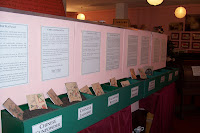
It seemed unlikely that a country not known for wine production should be host to a wine museum. Such is the case at Vinopolis: City of Wine located on London’s Southbank. Built in the vaults of a former wine warehouse, the museum offers a breezy history of wine with plenty of tasting opportunities. You have your choice of dozens of reds, whites and ports. The exhibits focus on the production of wine and its development in different regions of the world. You can even ride a Vespa with a video of the Tuscany wine country projected on the windshield.

You can either choose to rush to each of the three wine tasting stations or take your time with the audio tour. Being that it was only 12noon, I opted for the 'original' tour of five wine tastings. The museum is compact but offers many areas to lounge and sip your wine. Each wine tasting station has crackers and water dispensers to wash your glass. The knowledgeable wine servers can help you choose your next taste of wine. The tasting choices come from all over the world from the well known regions of Italy to the unknown commodities from Thailand.
There is one room devoted to the Bombay Sapphire that feels more like a club in itself. All tickets include a Bombay Sapphire cocktail. Choose one and watch your bartender prepare the drink. It’s actually not a bad cocktail. I opted for a berry concoction if I remember correctly as I opted to have this drink after all five wine tastings.

Of the five wines I tasted, my favorite was from Argentina called a Finla El Ritero. The server explained if you enjoy a Riesling, this wine is very sweet and is a late harvest wine. Now the wine from Thailand had something to be desired in its unusual bouquet. According to the server, it is meant to be served with spicy Thai foods which may negate the unusual aroma.
For those of a stronger drinking fortitude, you can add whisky, beer and champagne or more wine tastings. Vinopolis also offers Absinthe. Now Absinthe is not available in the U.S. and therefore gives this product a mysterious quality. Try it if you dare. The green drink is thought to be dangerously addictive and have harmful effects on one's health. In 1915 the drink was banned in the U.S. and is still banned today. More European countries have become more accepting of the drink in recent years and have lifted their bans.

Find something you really like during the museum tour. Visit the Majestic Wine Warehouse and the Whisky Shop for purchases. Be mindful that these products may have to be declared at customs and will not be allowed on board aircrafts.
Admission:
- Original Tour GBP16 (self- guided tour includes five wine tastings, a Bombay Sapphire cocktail and wine tasting notebook).
- Discovery Tour GBP21 (includes benefits of original tour plus 2 whisky tastings, 2 absinthe tastings, 2 beer tastings and "How to Taste Wine" session)
- Vintage Wine Tour GBP26 (includes benefits of original tour plus 3 extra regular wine tastings, 4 premium wine tastings)
- Champage Tour GBP31 (benefits of vintage wine tour plus 3 Ruinart Champage Tastings).
Located near Shakespeare’s Globe Theatre and the Tate Modern, the closest tube stop is London Bridge Station. Open daily from 12noon-6pm; open until 9pm on Mon, Fri & Sat. Also onsite is a bar and restaurant. More info at
www.vinopolis.co.uk. Pictured below (from top): bar at the Bombay Sapphire Experience; the wine god Bacchus and Vespas (see the video on the windshields); and Wine Warehouse shop.



 There has been three theatres on this site since 1832. The theatre that is now the Victoria Palace holds 1,550 seats and was built in 1910 at a cost of GBP12,000. Like many theatres in London built during the time, originally the Stalls, Dress Circle and Grand Circle each had their own box office and entrance denoting the current classes of its citizens. The theatre has been refurbished since to no longer reveal this out-moded class system distinction.
There has been three theatres on this site since 1832. The theatre that is now the Victoria Palace holds 1,550 seats and was built in 1910 at a cost of GBP12,000. Like many theatres in London built during the time, originally the Stalls, Dress Circle and Grand Circle each had their own box office and entrance denoting the current classes of its citizens. The theatre has been refurbished since to no longer reveal this out-moded class system distinction.










































